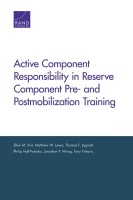| 来源类型 | Research Reports
|
| 规范类型 | 报告
|
| ISBN | 9780833087836
|
| 来源ID | RR-738-A
|
| Active Component Responsibility in Reserve Component Pre- and Postmobilization Training |
| Ellen M. Pint; Matthew W. Lewis; Thomas F. Lippiatt; Philip Hall-Partyka; Jonathan P. Wong; Tony Puharic
|
| 发表日期 | 2015
|
| 出版年 | 2015
|
| 页码 | 132
|
| 语种 | 英语
|
| 结论 |
The Provisions of Title XI Were Intended to Address Readiness Problems in Reserve Component (RC) Units Mobilized for Operation Desert Storm - Title XI assigned active component advisers to RC units to increase the quantity and quality of full-time support.
- Title XI established a program to minimize postmobilization training time by focusing premobilization training on individual soldier qualifications and crew-, squad-, and platoon-level training.
Army RC Training Support Organizations Evolved to Support the Rotational Demand for Forces in Iraq and Afghanistan - By 2001, the Army had consolidated active component advisers into multicomponent training support organizations known as First and Fifth Army.
- After 2007, when RC mobilizations were limited to one year, First Army shifted its focus to postmobilization training, and the Army National Guard and Army Reserve increased premobilization training support.
- Premobilization training focused on soldier readiness processing and individual soldier qualifications; most collective training occurred immediately before mobilization or after mobilization.
The Army's Future Training Plans Suggest That RC Units Will Focus on Collective Training During the Train/Ready Phase of the Army Force Generation Cycle - Given past experience, company-level live fire and maneuver proficiency will be difficult for combat units to achieve in premobilization training.
- If individual soldier qualifications and training requirements are not met prior to mobilization, these tasks will have to be completed after mobilization, affecting the training support resources that will be needed.
|
| 摘要 |
- Given experience from both the 1990s and more-recent operations, premobilization training should focus on individual soldier qualifications and collective training at the crew, squad, and platoon levels, particularly for combat units.
- The Army should maintain a multicomponent RC training support structure to ensure that training standards do not diverge across components.
- While some provisions of Title XI remain relevant, others no longer reflect the current operating environment and should be changed.
|
| 主题 | Military Education and Training
; Military Mobilization
; Military Reserves
; Operational Readiness
; United States Army
|
| URL | https://www.rand.org/pubs/research_reports/RR738.html
|
| 来源智库 | RAND Corporation (United States)
|
| 资源类型 | 智库出版物
|
| 条目标识符 | http://119.78.100.153/handle/2XGU8XDN/107968
|
推荐引用方式
GB/T 7714 |
Ellen M. Pint,Matthew W. Lewis,Thomas F. Lippiatt,et al. Active Component Responsibility in Reserve Component Pre- and Postmobilization Training. 2015.
|
|
文件名:
|
x1495316215083.jpg
|
|
格式:
|
JPEG
|

|
文件名:
|
RAND_RR738.pdf
|
|
格式:
|
Adobe PDF
|
除非特别说明,本系统中所有内容都受版权保护,并保留所有权利。